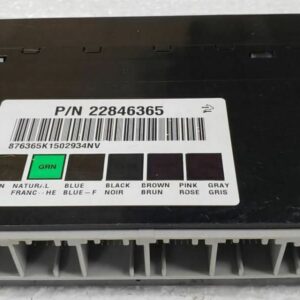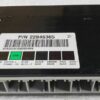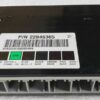Restore Your Truck’s Brain and Banish Electrical Gremlins
As a technician with over two decades of experience, I’ve seen firsthand how a failing Body Control Module (BCM) can turn a reliable truck into a source of constant frustration. Are your power windows acting possessed? Do your dash lights flicker randomly? Is the security system preventing you from starting the engine? These aren’t separate problems; they’re classic symptoms of a BCM on its last legs. The BCM is the central command hub for your vehicle’s body electronics, and when it fails, it creates chaos. This module is the definitive solution, arriving at your door pre-programmed to your truck’s specific VIN.
Common Symptoms of a Failing GM BCM
- ✔ Power windows, door locks, or mirrors operate intermittently or not at all.
- ✔ Interior or exterior lights flicker, stay on, or won’t turn on.
- ✔ The security or anti-theft light is illuminated, causing a no-start condition.
- ✔ The radio or infotainment system behaves erratically.
- ✔ False warnings appear on the instrument cluster (e.g., “Service 4WD”).
- ✔ Diagnostic trouble codes (DTCs) related to communication, often U-codes like U0140, U0155, or U0100.
Case Study: A Tricky Diagnosis
A 2013 Silverado 2500 came into my bay with a complaint that stumped two other shops: it would intermittently fail to start, but only on hot days after being driven. The battery and starter checked out perfectly. When it acted up, the dash would go haywire, and the gear indicator would vanish. A scan showed a flurry of communication codes. Instead of chasing individual components, I went straight for the BCM. After swapping in a new module, the communication network stabilized, and all the bizarre symptoms disappeared. That’s the power of targeting the root cause, and this 2012-2014 Sierra BCM is designed to be that reliable root-cause fix.
A Straightforward Guide to Your BCM Installation
Replacing the BCM is a manageable job for a confident DIYer. It’s located under the driver’s side of the dashboard, near the steering column. Because we program it to your VIN, you can skip the expensive trip to the dealership for software flashing.
- Safety First: Disconnect the negative terminal from your vehicle’s battery and wait at least 10 minutes to ensure all systems are powered down.
- Access the Module: Remove the lower dash panel beneath the steering column to gain access to the BCM. It’s typically held in a plastic bracket.
- Disconnect and Remove: Carefully unplug the multiple electrical connectors. They have locking tabs that need to be depressed. Once disconnected, unclip the old BCM from its mounting bracket.
- Install the New BCM: Snap your new, pre-programmed BCM into the bracket and securely reconnect all electrical connectors. You should hear a click as they lock into place.
- Reconnect and Test: Re-install the dash panel, reconnect the battery terminal, and start the vehicle. Test all body functions like lights, windows, and locks to confirm the repair.
Important Post-Installation Notes
In some cases, your vehicle may require additional steps to fully sync the new module. This is normal and depends on your truck’s specific configuration.
- Airbag System Sync: If the airbag warning light is on after installation, a ‘Setup SDM Primary Key in BCM’ procedure must be performed with a compatible professional scan tool. This syncs the new BCM with the airbag system.
- Brake Pedal Position Relearn: To ensure proper brake light and traction control operation, a brake pedal position sensor relearn may be required. This also requires a bi-directional scan tool.
- No Core Charge: You are not required to return your old module. Keep it, discard it, or save it for diagnostics—the choice is yours.
Disclaimer: Vehicle systems can vary. We always recommend consulting a factory service manual or a certified technician if you are unsure about any part of the process.
Guaranteed Fitment for Your GM Truck or SUV
This BCM, part number 22846364, is a direct replacement for part numbers 22737275 and 22846365. It is compatible with a wide range of GM vehicles, including:
- Cadillac Escalade, ESV, EXT (2012-2014)
- Chevrolet Avalanche 1500 (2012-2013)
- Chevrolet Silverado 1500, 2500, 3500 (2012-2014)
- Chevrolet Suburban 1500, 2500 (2012-2014)
- Chevrolet Tahoe (2012-2014)
- GMC Sierra 1500, 2500, 3500 (including Denali) (2012-2014)
- GMC Yukon, Yukon XL (including Denali) (2012-2014)
To ensure perfect compatibility, we program this 2012-2014 Sierra BCM using the VIN you provide at checkout. This ensures all your vehicle’s original options and features function correctly right out of the box.
Frequently Asked Questions
Why do you need my VIN?
We use your Vehicle Identification Number (VIN) to load the exact, factory-correct software for your truck’s specific features and options. This makes the installation process as close to plug-and-play as possible and avoids a trip to the dealer.
Is this part difficult to install myself?
For someone with basic mechanical skills, this is a very manageable job. The BCM is located under the dash and requires removing a trim panel for access. The main challenge is unplugging the connectors in a tight space. Our pre-programming saves you the most complex step.
What tools are needed for the post-installation procedures?
The Airbag System Sync and Brake Pedal Position Relearn require a professional-grade, bi-directional scan tool. Many local repair shops can perform these procedures for a small fee if they are needed for your vehicle.
Will this fix my ‘Service StabiliTrak’ message?
A faulty BCM can sometimes cause StabiliTrak or traction control warnings due to lost communication with other modules. While this module can resolve such issues, it’s important to have the vehicle properly diagnosed, as other sensors can also cause this warning.
What if my original part number is 22737275?
This module, 22846364, is a fully compatible and interchangeable replacement for part numbers 22737275 and 22846365. We will program it to function identically for your vehicle.



